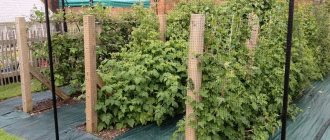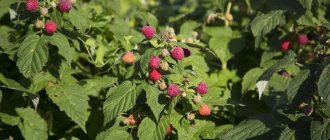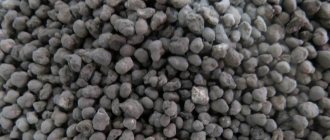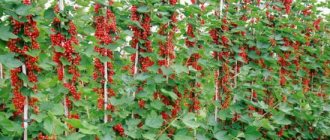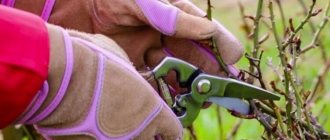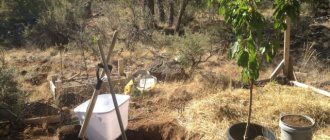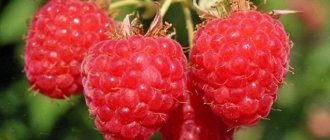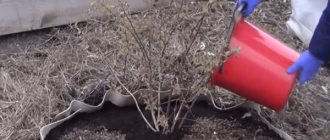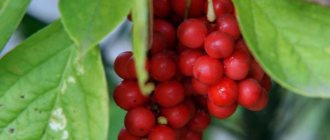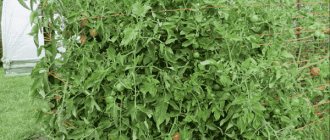What is the Sobolev method?
Every agronomist interested in increasing raspberry yields is familiar with the method of Alexander Georgievich Sobolev. He devoted many years of his life to working on caring for the crop and conducted over fifty tests on his own raspberry bushes. As a result, a new way has emerged to double the berry yield without the use of complex agricultural techniques.
Did you know? First
Raspberries
were discovered by the Romans on the Greek island of Crete. This happened back in the 3rd century BC. e.
Rules for planting bushes
The raspberry bush is quite unpretentious and can grow in almost any conditions. To obtain a high yield, the agronomist advises adhering to the following planting rules:
- It is important to place the direction of the beds from north to south. The site should not be subject to stagnation of rain, swamp and groundwater.
- The place should not be too weathered, so it is better to plant it near fences.
- The beds must be fenced with slate or wooden blocks, raising them 12–20 cm above the ground. This way, water will only fall on the plantings, without flowing beyond them.
- The average length of a bed is about 1 m, it all depends on the number of bushes planted. Maintaining a meter distance between bushes will help avoid the appearance of diseases on the plant, maintain proper ventilation and a sufficient amount of light.
- Before planting, it is better to fertilize the area, for example, with a mixture of humus, potassium and superphosphate.
- Planting is carried out in early autumn. One bush is placed in a deep hole (about 40 cm). If you combine several seedlings in one hole, there will be a lack of nutrients and the plant may die. If planting rules are followed, raspberries can grow in one place for up to 15 years.
Why do you need to prune raspberries in spring?
Sobolev recommends paying great attention to double pruning of raspberry bushes. Thanks to the unique method, the number of flowers and the yield period are increased.
If planting was in the fall, then the first pinching should be done in late spring or early summer . This will help the young shoots to branch freely, and the bush will not be very tall. Bushes that are too long give low yields and interfere with the formation of new shoots.
Important! Deadline for first cut
—
July 10.
If you don’t have time, the new side branches will not ripen and will freeze in winter. The second pruning of blossoming leaves and side shoots is carried out exactly one year later. This affects the growth of fresh buds and the awakening of old ones . The first pruning of raspberries according to Sobolev is considered a preparatory stage. And only after the second one can you get a visible result.
Deadlines
After the snow melts and the soil and air temperatures are equal, you can begin normalizing the raspberry shoots. The exact timing depends on the climate and temperature stability. The calendar periods for pruning are March-April or April- May. In the southeastern regions of Ukraine and Russia, pruning before April is not recommended. And in countries with a milder and warmer climate, it can be carried out as early as early March.
Did you know? According to legend, the first raspberry garden was founded by a great ruler, the founder of many Russian cities.
-
Yury Dolgoruky.
Today Russia is the world leader in raspberry cultivation (over 200 thousand tons of crop per year). Traditional spring pinching is followed by summer pinching. It occurs during the harvest period (around August). Dying branches should be removed. This will help the formation of new shoots and create better lighting. When planning pruning, it is important to take into account the characteristics of the shrub variety and the volume of fruiting per year.
Spring raspberry care
It starts with tying up the bushes. This should be done as early as possible in order to have time to carry out all the work before active sap flow begins. Buds that are already ready to open are very easy to break off, and this leads to the loss of part of the harvest. In central Russia, the season for caring for raspberries begins when the snow melts and above-zero temperatures set in (approximately at the beginning - the second half of April). In the northern regions (for example, in Buryatia), work in the raspberry field begins later - at the end of April-beginning of May.
The ground in spring is very soft; Be careful not to trample it while working. Too dense soil, especially clay soil, interferes with the normal growth of raspberries. Experienced gardeners recommend laying “paths” of boards in the raspberry field.
How to do pruning according to Sobolev: diagram
The work can be divided into several stages:
- First of all, you need to get rid of branches that have already stopped bearing fruit or have begun to die. This procedure is carried out provided that pruning is not done in the fall.
- Frozen shoots are removed. They are identified by their dry appearance and the absence of swollen buds. Pruning goes to the first living bud.
- Young shoots must be dug up and cut off at the root. It is better to do this with pruning shears or a shovel, cutting off the sprouts. It is not recommended to pull out or dig up the shoots, because the mother and daughter shoot systems are connected.
- Next they do the transplantation. There should be no more than 30 plants per 1 m². One bush should have 5–6 strong underground shoots. If something is missed, the indicator can always be corrected in the spring.
- The height of the specimens should be reduced to 1.5 m.
Important! The pruning shears or shovel must be sharp and clean. This will prevent infection or damage to the plants.
A good harvest can be obtained by cutting raspberries at different heights. In this case, ripening will be gradual: from high to low bushes.
Bush pruning scheme:
- reduce by 10–15 cm;
- cut to 20–30 cm;
- shorten by 70 cm (50% of the shoot);
- leave 15–20 cm.
Video: Double pruning of raspberries according to Sobolev
Raspberry planting
In the fall, you need to prepare the site and soil for planting the crop, purchase suitable varieties for the region where you live. Plant the bushes, taking into account the recommendations of Sobolev’s experience, with a distance of 1.5 m between rows and 0.7-1 m between bushes.
Raspberry harvest. The illustration for the article is used under the standard license ©ofazende.ru
At the end of September and beginning of October, you need to treat the crop against pests, even if gardeners recommend not to do this.
The fact is that different varieties of fruit trees and shrubs with different characteristics grow on the site.
At the end of November, bushes and row spacing should be mulched with straw, humus, with the addition of ash, and mown grass. This will serve as both insulation and nutrition. In early spring, with melting snow and rain, the raspberry roots will receive all the nutrients from the mulch.
Related article:
A method that will increase the yield of raspberries, currants and gooseberries
Double pruning: pros and cons
This Sobolev method is quite simple to use, but it also has its pros and cons.
- Advantages:
- high berry fertility;
- increasing the harvest period from July to September;
- effectiveness of the method;
- ease of implementation;
- ease of harvesting due to the density of the fruit.
- Flaws:
- increase in work volume;
- climate dependence;
- excessive thickening of raspberries;
- high requirements for soil nutrition;
- selection of suitable varieties;
- root growth;
- risk of disease development on weak plants.
Despite the disadvantages, gardeners often resort to this method. The choice is justified by the high yield and increase in the fruiting period of raspberry bushes.
Did you know? A. G. Sobolev received 135 kg of harvest on a plot of 50 m
²
thanks to double cutting. In the 80s XX century The magazine "Homestead Economy" was the first to publish information about the new method.
Double pruning of raspberries: increasing yield with pruning shears
This was in the 80s of the last century. The author of the method was A.G. Sobolev, an amateur gardener, who sent a letter to the newspaper Homestead with a story about his method of increasing raspberry yields.
The know-how shocked the world of gardeners: the editors received 64,000 letters from interested and grateful readers. Not electronic - paper. Still: the method increased productivity significantly.
The test gardener himself achieved impressive results: a control plot of 50 acres yielded 135 kg of raspberries!
In those days, this was a record number: the varieties were unproductive, with a small fruiting zone. Not only pruning, but also rationing of shoots helped to achieve such results.
How did you manage to do this? Simple: leaving about 4 fruiting stems and up to 8 replacement shoots per bush, maintaining a distance of 2 m between bushes.
- In the first year, four rows with a density of 15-20 shoots per bush were placed on a control plot of 50 m2. The final output barely reached 30 kg.
- The following year, the distance between the bushes was increased to 2 m, and the row spacing was also increased to 3 m. As a result, two rows of raspberries with fewer shoots showed a yield of 75 kg.
- Alexander Grigorievich reached maximum productivity in the fourth year, reducing the number of shoots to 4 in the bush. From the same 50 acres, 135 kg of excellent quality berries were collected.
Today A.G. Sobolev is called the patriarch of raspberry farming, raspberry Michurin. His method is used, although it has not become a classic method of agricultural technology, unlike many mistakes and misconceptions.
Double pruning raspberries: the essence of the method
What is the essence of double pruning? In the first year, at the end of May and until the beginning of June, annual stems are not simply pinched, but cut to 10-15 cm. To what height depends on the growth vigor of a particular variety.
On the advice of the author of the method A.G. Sobolev, tall raspberries are pruned at a height of 90-100 cm, medium- and low-growing varieties - when they reach 60-70 cm.
The agricultural method gives intensive lateral branching: after a few days, dormant buds wake up in the axils of the raspberry leaves. The “stepchildren” begin to grow intensively, and next year they will produce an abundant formation of fruit branches, laterals bearing color and ovary.
In the second year, the tops of the side shoots are already cut off by 5-15 cm, depending on the length, which gives them intensive branching and the formation of up to 20-30 additional side branches, according to A.G. himself. Soboleva.
Sometimes they practice double pruning in one year. The stems are shortened at a height of 30-40 cm, then branched laterally when the same length is reached.
The method is not suitable for all varieties, and use is experimental.
About the disadvantages of the double method
There are also disadvantages to double pruning. This is a high density of plantings with all the ensuing consequences - poor lighting and ventilation.
The higher the planting density, the higher the yield - at the beginning the author of the experiment came to this conclusion, which he admitted was erroneous. However, high yields due to the high density of plantings are obtained on commercial plantings, but with intensive agricultural technology, which is not suitable for the gardener.
The optimal density of shoots is considered to be 4-6 shoots per m2 for a garden, from 7-12 for commercial plantings.
On the latter, a density of up to 20-30 stems per m2 is used with a wide-row planting method, but gardeners and small farms should not focus on industrial plantings: thickening involves intensive fertilizing, drip irrigation, and mowing with herbicides. And – frequent change of planting material: turnover is often carried out in a two- or three-year cycle.
But what about commercial wide-strip plantings, or with a density of 12-15 pieces and up to 15-30 per m2?
And there are completely different agricultural cultivation techniques, different from garden or small production. These include intensive fertilizing and drip irrigation. And the main thing is fast turnover: planting in a two- to three-year cycle.
Step-by-step instruction
The essence of double pruning is precise timing and maintaining planting density.
First trim
The first pruning is carried out in late May-early June. Then the new shoots grow to 70–100 cm. The top is removed by 10–15 cm, this helps to awaken the side shoots from the swollen buds. By the end of summer they reach up to 0.5 m in length. It is on them that in a year branches with large and juicy berries will form.
The purpose of the first pinching is to increase the phytomass by 1 m². The main thing is to comply with the deadlines, otherwise the new shoots will not be able to grow strong enough and risk freezing in the winter. It is important to remember the correct agricultural technology
Second trim
Exactly a year later, in the spring, the bushes are pruned again. The tops are cut off by 10–15 cm. By this time, the raspberries are already covered with a large number of new leaves. As a result, the growth of dormant buds is stimulated. New shoots are ripening on which fruiting will occur. The berries will ripen alternately until late autumn.
Advantages of the technique
I prefer the Sobolev method, since it increases the number of flower buds, and therefore the ovaries. As a result, the fruiting period increases and the overall yield increases. But the method only works if all agrotechnical techniques are correctly applied, including the rules of planting, fertilizing, and watering.
Shortening the raspberry stem promotes the development of lateral shoots with ovaries
The primary pruning is preparatory, and the second gives a tangible result if all the rules of the technique are followed. As a result, by the time of fruiting, the shrub resembles a lush tree, covered with flowers and ovaries.
In addition to the Sobolev method, I use preventive autumn pruning, removing damaged and diseased shoots. If I encounter dense areas in the raspberry field, I shorten the side shoots again to limit their development.
Regular care helps me give regular raspberry varieties the properties of remontant ones. Pruning according to Sobolev is the best way to create a beautiful fruit-bearing raspberry tree on your plot, which will produce a harvest until late autumn.
Irina Ivanovna, gardener
Is it worth double pruning remontant varieties?
Remontant raspberries belong to the group of varieties that are capable of bearing fruit on both biennial and annual shoots. The question arises: is it worth doing pruning using the Sobolev method? There are certain nuances here.
In autumn, after the first year of life, fertilized shoots ripen to the roots, so it is better to prepare before the first frost. The bushes are not removed at the root, but only the top is removed. In the second year, raspberries continue to bear fruit due to regrown side shoots. Biennial shoots are removed immediately after harvest. It is important to control growing shoots.
Important! When choosing remontant raspberries, you need to pay attention to how many times it bears fruit during the year. For example, varieties Hercules, Indian Summer, Indian Summer
—
Sobolev method 2 is not suitable.
Bushes that bear fruit once a year are removed at the root . In summer, the harvest is harvested from the shoots of the first year. It is not recommended to cut such varieties using the double pruning method, since the next shoots do not have time to ripen and the harvest shifts closer to winter. This entails a decrease in yield.
Reviews about the Sobolev method
Konstantin, Ekaterinburg
It is best to use the Sobolev method on very young or old raspberry bushes. They don't produce much root growth. The method works well on two-year-old bushes.
Galina, Omsk
The method does not work on all raspberry varieties. I have two bushes in my garden that were inherited from the previous owners. What kind of variety is unknown. One bushes well and produces a harvest, while on the second, side branches do not appear. Therefore, I advise you to check it first on one bush.
Raisa, Krasnodar
I've heard a lot about this method. I decided to try it on my bushes. But nothing happened; the side branches did not have time to grow stronger and begin to bear fruit.
Asya, Tyumen
I heard about this method and decided to try it on my raspberry bushes. And it really works. Previously, we collected up to a couple of cups from a whole raspberry tree, but now we collect it in buckets.
Features of care using the Sobolev method
One of the important stages of growing raspberries is subsequent care.
The main rules include the following:
- Timely and regular watering . It is important to avoid drying out the soil.
- It is recommended to avoid loosening the soil . The roots of the bush are too close to the surface and can be damaged. Weeding the beds should be done regularly (so that the bush does not become overgrown with weeds), but very carefully.
- Mulching . Raspberries love moisture, but do not tolerate stagnation of water. In this case, Sobolev recommends covering the soil with mulch in the form of cow and horse manure. The ground must be covered with 10–20 cm of material and filled with water. The formed crust will nourish and fertilize the plants. If there is no manure, then you can use plant tops, peat, shavings or any other material that prevents moisture evaporation. You can also lay a layer of old newspapers as mulch and cover them with compost. These methods are great for growing raspberries in the country when there is no constant access to watering. It is important to know that the mulch layer should not exceed 5 cm, otherwise it will be difficult for the root system to “breathe” normally and poor shoot development will negatively affect the harvest.
- Shelter for the winter . The surviving shoots are bent to the ground and secured with metal staples. To protect from frost, cover the top with tarpaulin or agrofibre.
- Feeding . If the shoots dry out, curl or turn pale, then they need feeding. A tincture of bird droppings and wood ash works well. To do this, 3 liters of droppings are mixed in 6 liters of water and left for two days. After this, 1 liter of this infusion should be poured into a bucket and a little wood ash should be added. The mixture is ready. Under normal soil conditions, such fertilizing is applied 2-3 times a year.
- Pest protection . Many gardeners who grow raspberries recommend treating raspberries with a 1% solution of Bordeaux mixture in early spring, before the growing season begins, and in the fall, after harvesting. This eliminates the appearance of pests in the garden.
Caring for raspberries using the Sobolev method is not difficult. The main thing: follow all the above recommendations, take into account the characteristics of the variety and care. Then you will be able to collect a lot of admiring reviews about your own harvest and not look back at old technologies.
